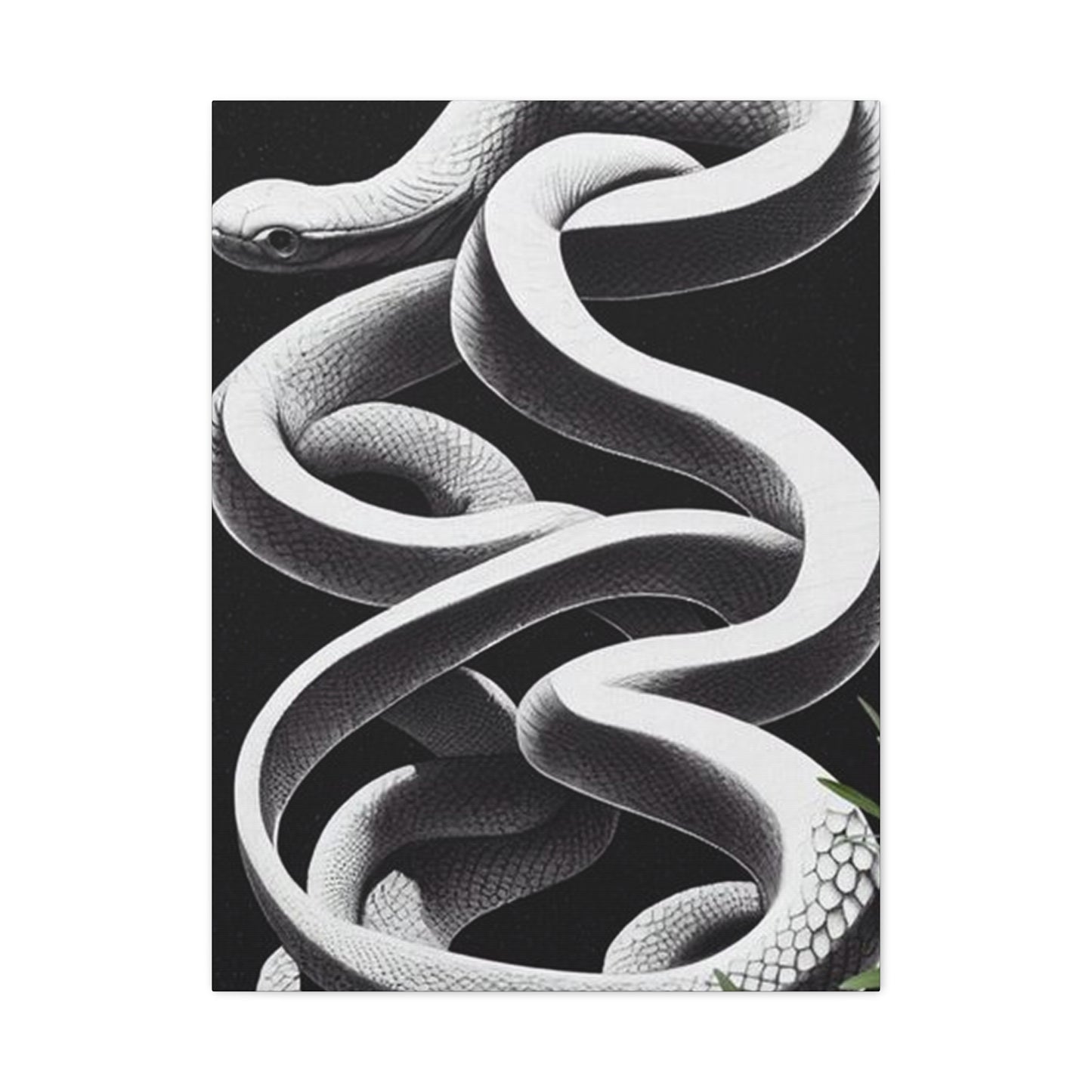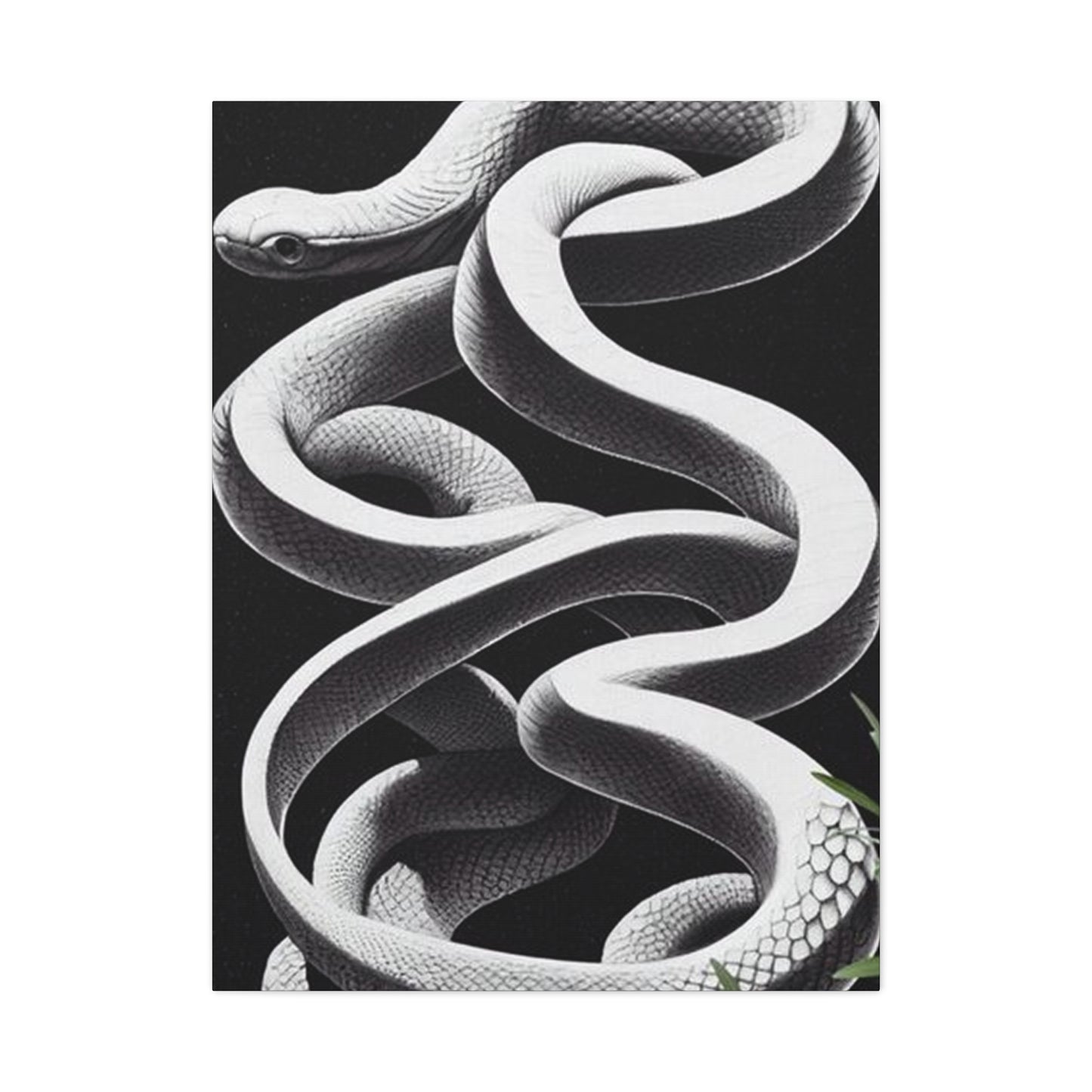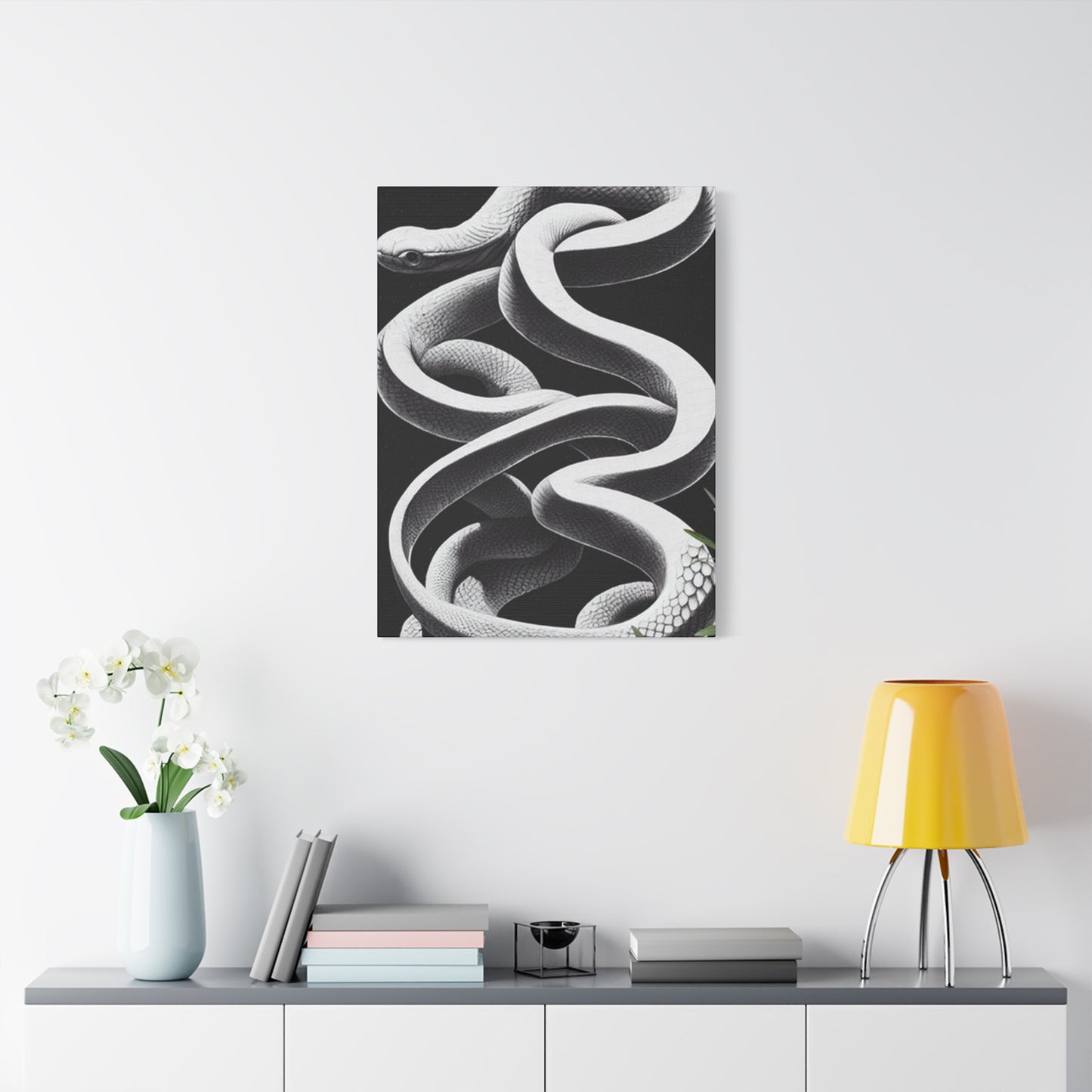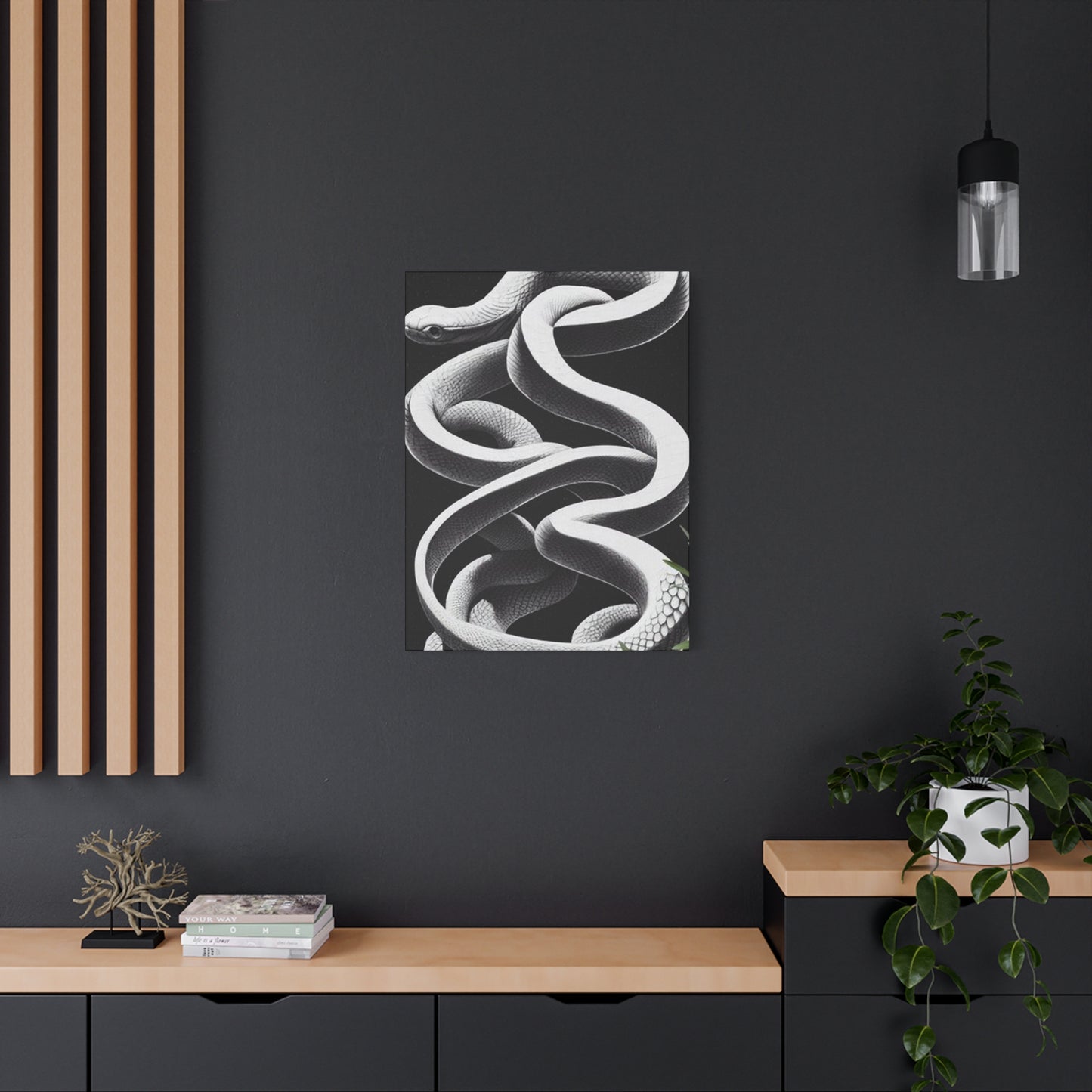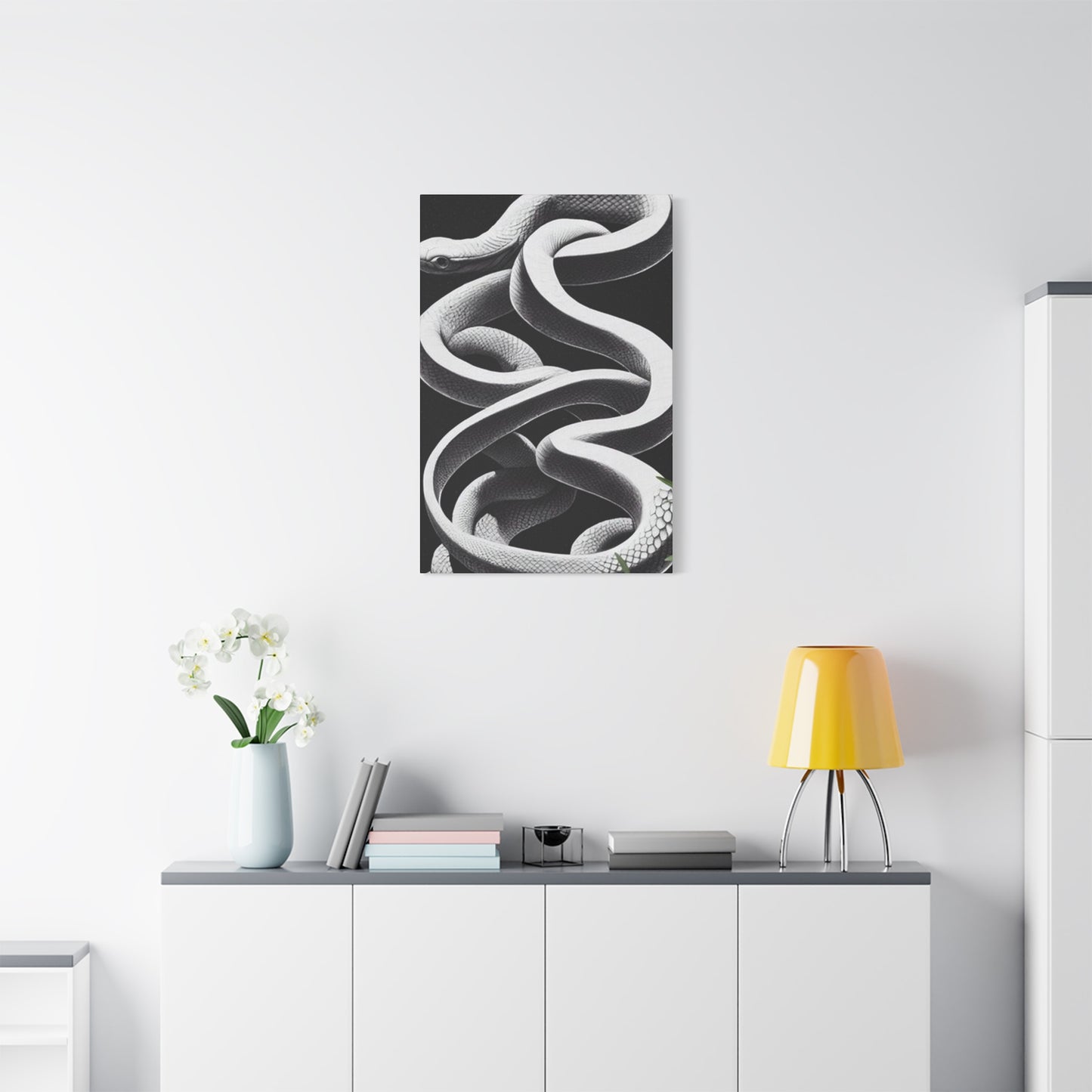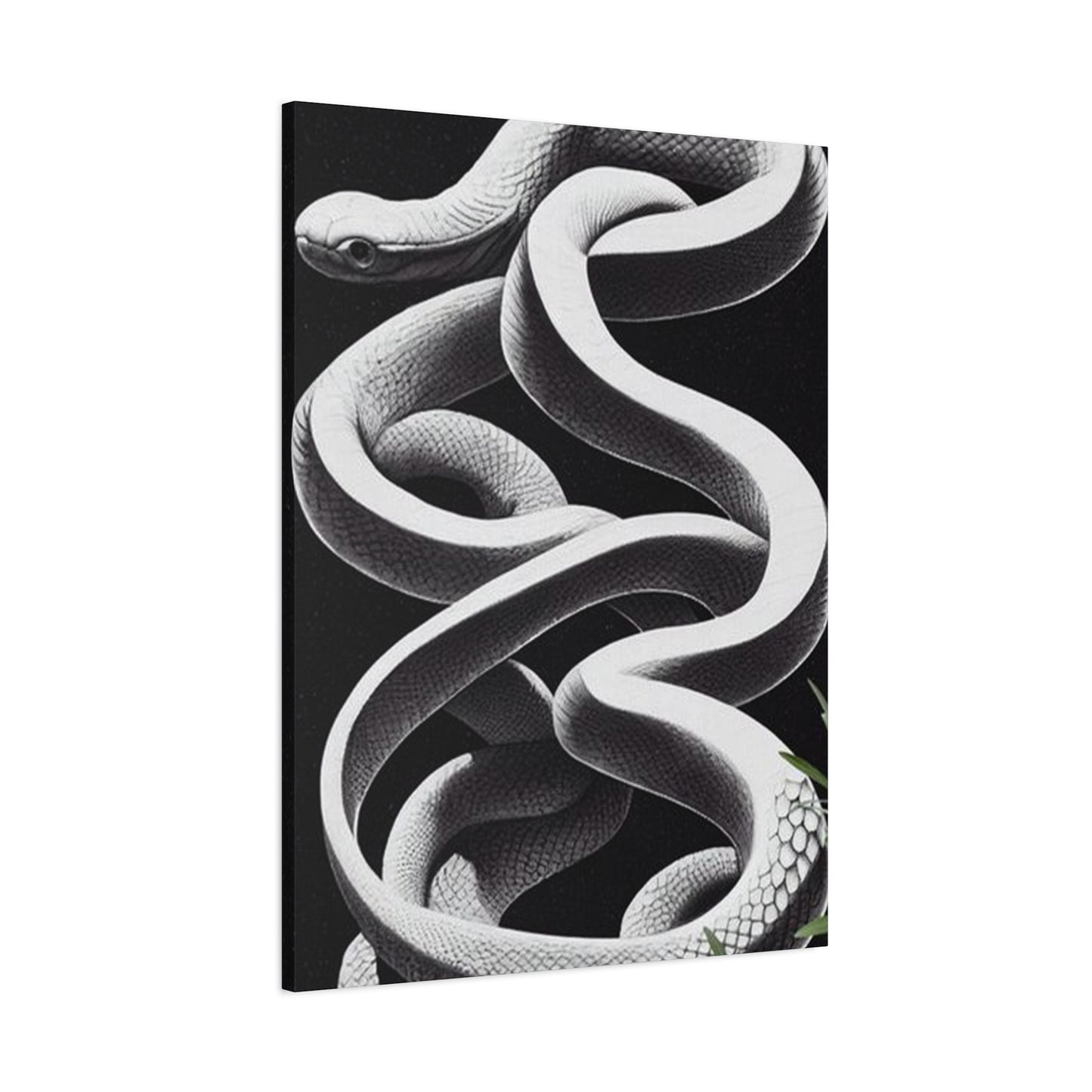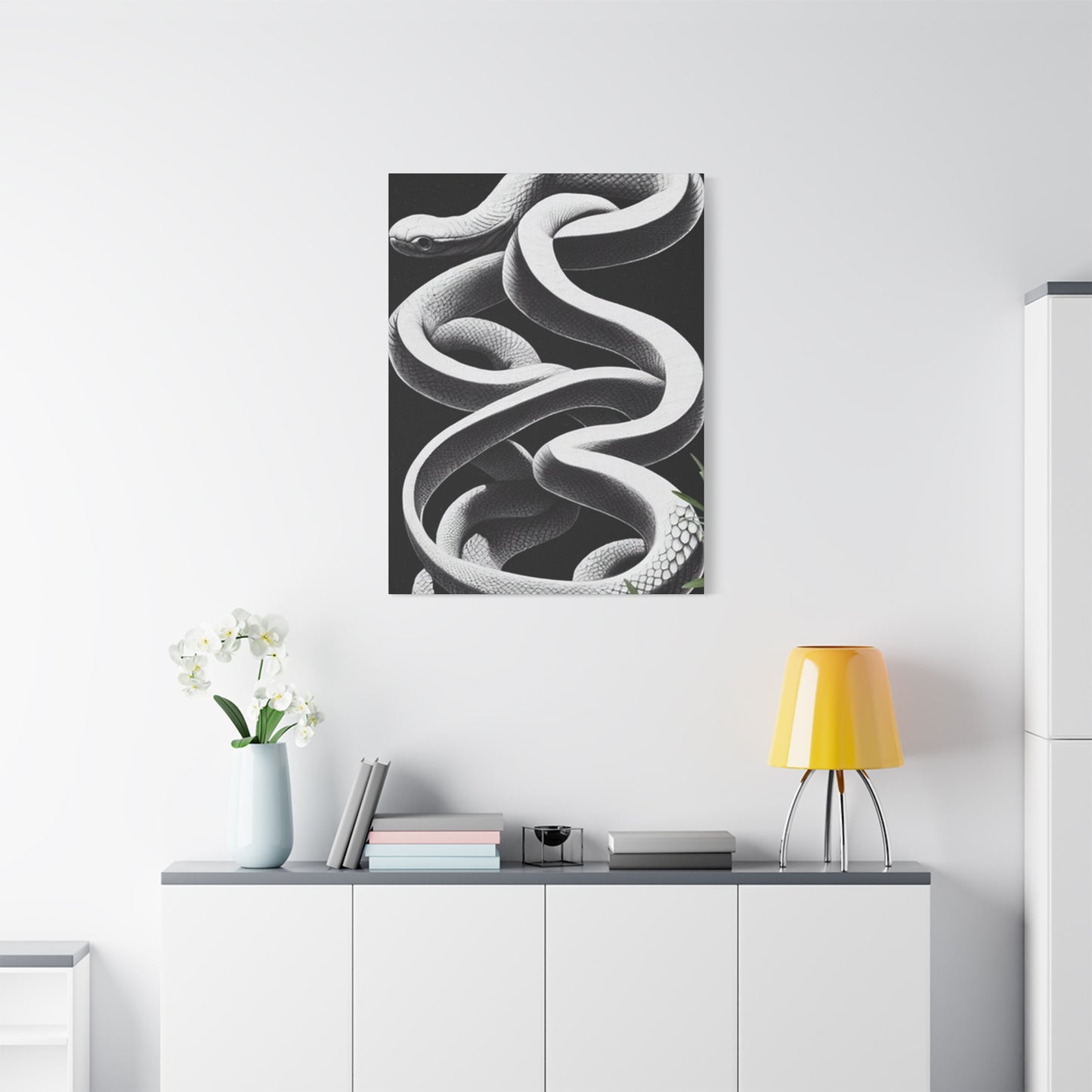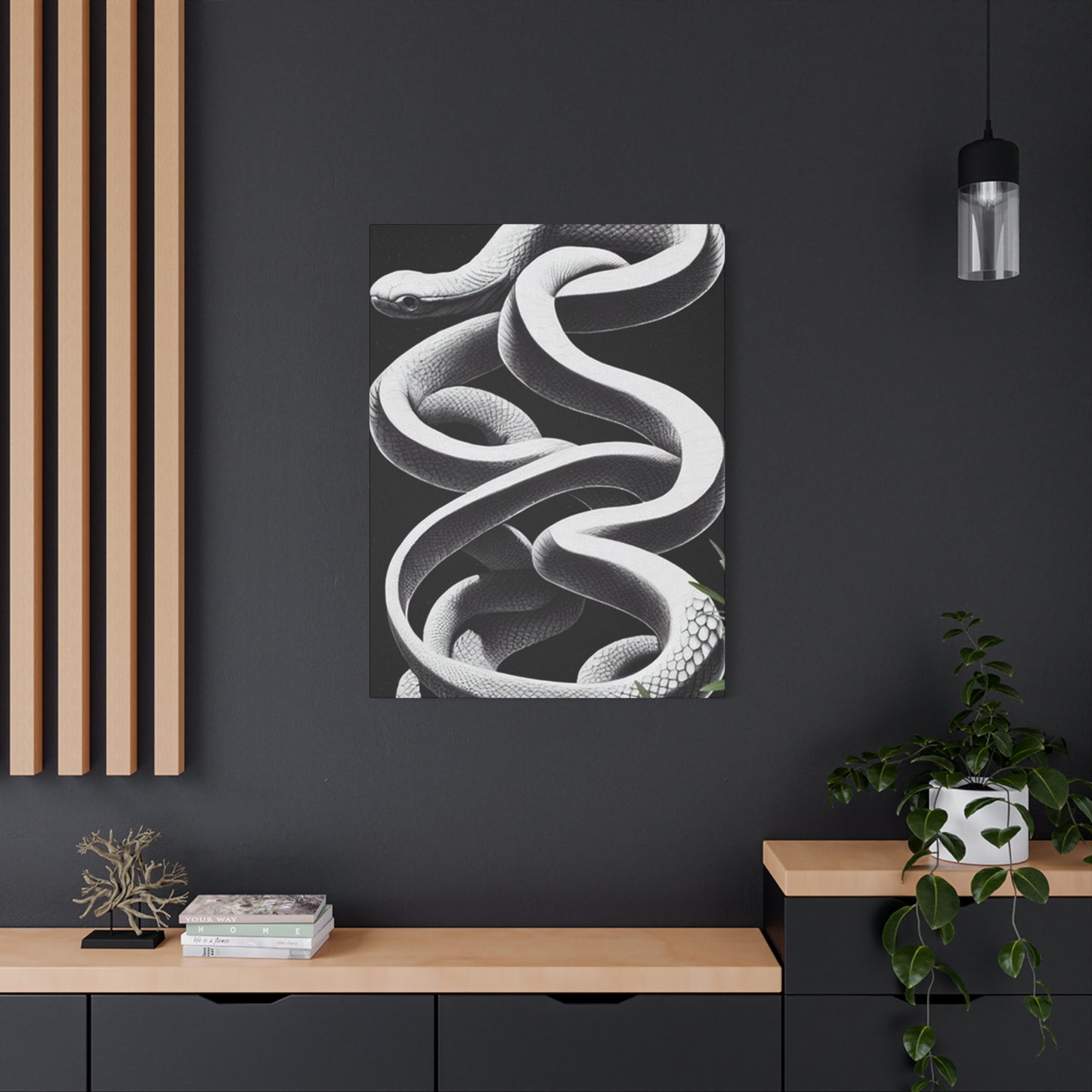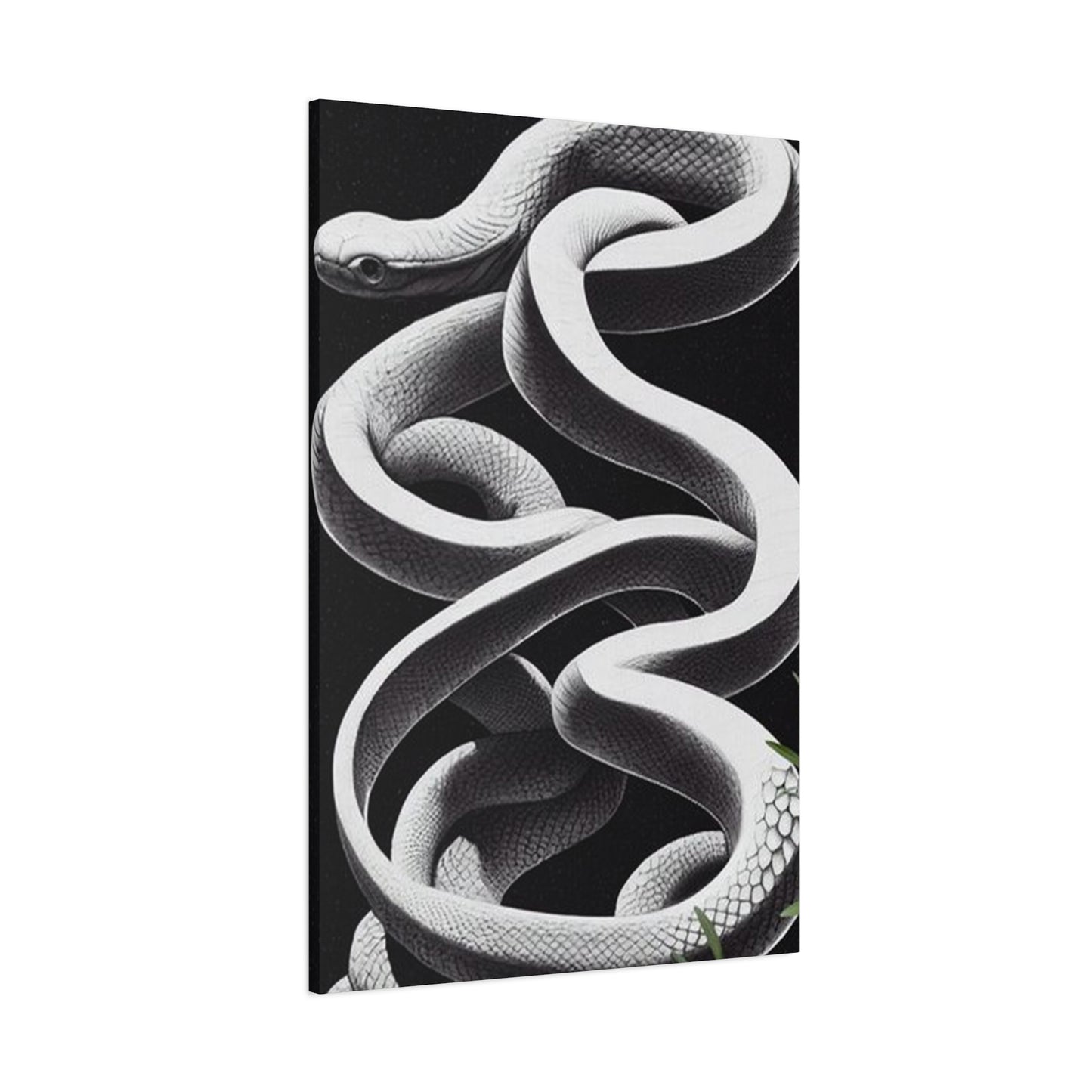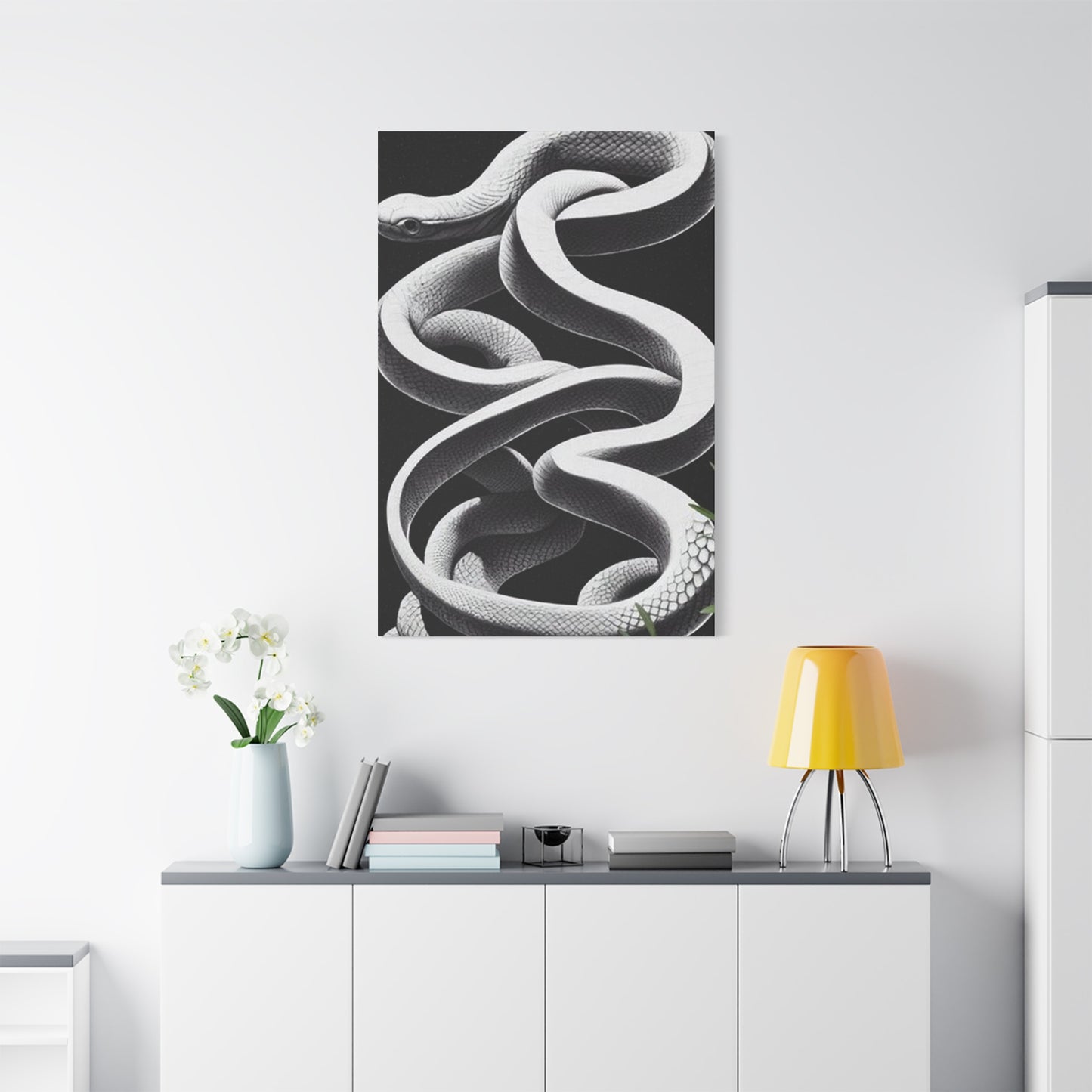White Snake on Black Poster Wall Art: Symbolism and Spiritual Significance
The visual power of serpent imagery rendered in stark monochrome has captivated interior design enthusiasts and art collectors for generations. When you place a serpent rendered in pale tones against a dark backdrop, you create an immediate focal point that commands attention while maintaining an air of sophisticated mystery. This combination of reptilian form and high-contrast color schemes offers endless possibilities for those seeking to infuse their living spaces with drama, symbolism, and contemporary edge.
The intersection of natural world inspiration and graphic design principles creates artwork that transcends temporary trends. Serpent imagery has persisted through millennia of artistic expression, yet when executed in a stripped-down palette, it feels remarkably current and fresh. The absence of color allows the form itself to speak, emphasizing curves, scales, and the inherent geometry of these fascinating creatures.
Interior spaces benefit enormously from the addition of high-contrast artwork featuring these sinuous subjects. Whether your aesthetic leans toward industrial minimalism, bohemian eclecticism, or darkly romantic sensibilities, serpent artwork in monochrome offers versatility that few other decorative elements can match. The following exploration examines how to effectively integrate these powerful visual statements into various design contexts, understanding their deeper meanings, and maximizing their impact within your personal environment.
Serpent Imagery and Its Deeper Meanings in Monochrome Artwork
The serpent has carried profound symbolic weight across virtually every culture throughout human history. When artists choose to depict these creatures in stark contrasts of light and dark, they tap into archetypal imagery that resonates on both conscious and subconscious levels. The pale serpent specifically carries associations with transformation, as many species shed their skin in a process of renewal and rebirth. This natural phenomenon has made the creature a universal symbol for personal growth, change, and the cyclical nature of existence.
In Eastern philosophies, serpents represent kundalini energy, the dormant spiritual force believed to reside at the base of the spine. When depicted in artwork, particularly in simplified color schemes, this symbolism becomes even more accessible and powerful. The contrast between light creature and dark background can represent the emergence of consciousness from the depths of the unconscious mind, making such artwork particularly meaningful for spaces dedicated to meditation, reflection, or creative work.
Western traditions have more complex relationships with serpent symbolism. Biblical narratives associate the creature with temptation and forbidden knowledge, while Greek mythology presents serpents as symbols of healing through the Rod of Asclepius. This duality makes serpent artwork inherently intriguing, as viewers bring their own cultural backgrounds and personal associations to their interpretation of the piece.
The choice to render these creatures in monochrome rather than realistic coloration adds another layer of meaning. By stripping away naturalistic hues, artists create something more archetypal and universal. The pale serpent on dark background becomes a study in form, movement, and contrast rather than a representation of any specific species. This abstraction allows the artwork to transcend literal interpretation and function as pure visual poetry.
Contemporary interior design increasingly values artwork that sparks conversation and invites multiple interpretations. Serpent imagery accomplishes this while maintaining aesthetic sophistication. The sinuous curves of the serpent form create natural visual flow that guides the eye through the composition, while the dramatic contrast ensures the piece never fades into the background of your awareness.
When selecting serpent artwork for symbolic purposes, consider what aspect of the creature's meaning resonates most strongly with your intentions for the space. Transformation and renewal might be perfect themes for a bedroom or personal sanctuary, while protection and wisdom could suit an office or study. The beauty of working with such richly symbolic imagery is that it functions on multiple levels simultaneously, offering aesthetic pleasure while also serving as a daily reminder of concepts you find personally meaningful.
Contemporary Interpretations of Ancient Serpent Symbolism
While serpent symbolism reaches back to humanity's earliest artistic expressions, contemporary artists continually find fresh approaches to this ancient subject. Modern serpent artwork often combines traditional symbolic associations with current design sensibilities, creating pieces that honor historical significance while feeling completely relevant to contemporary spaces.
The stripped-down aesthetic of modern design finds perfect expression in simplified serpent forms. Where historical serpent depictions might include elaborate patterns, detailed backgrounds, or narrative elements, contemporary approaches often isolate the serpent against minimal or completely plain backgrounds. This reduction to essentials aligns with modern preferences for clean lines and uncluttered compositions while maintaining the powerful symbolic presence of the subject.
Digital creation tools have expanded the possibilities for serpent artwork. Artists can achieve precise symmetry, perfect gradations, and effects impossible with traditional media. These technological capabilities produce serpent imagery with a distinctly modern sensibility, even when the poses or compositions reference classical sources. The crispness and precision of digitally created work appeals to contemporary sensibilities shaped by interaction with screens and digital imagery.
Contemporary serpent artwork often plays with scale in ways historical pieces rarely did. Extreme close-ups focusing on the texture of scales, the geometry of coils, or the intensity of the serpent's gaze create abstract qualities that reward close viewing. Conversely, some modern pieces show serpents at such small scale within large compositions that they become almost subtle details rather than dominant subjects, creating visual interest through the tension between the subject's symbolic weight and its physical presence in the artwork.
The intersection of nature and geometry features prominently in contemporary serpent artwork. Artists might combine organic serpent forms with geometric patterns, mathematical grids, or architectural elements. This juxtaposition creates visual tension that speaks to current cultural themes around the relationship between natural and constructed environments, organic life and technology, chaos and order.
Social and environmental consciousness influences contemporary approaches to all nature-based imagery, including serpent artwork. While not necessarily conveying explicit messages, modern serpent pieces often carry undertones of species preservation, habitat protection, and recognition of nature's value beyond human utility. Choosing serpent artwork for your space can reflect these values, particularly when you select pieces from artists known for environmental advocacy.
Contemporary minimalism's influence appears in serpent artwork that reduces the subject to its most essential elements. Simple line drawings, silhouettes, or nearly abstract interpretations that suggest rather than fully depict serpent forms exemplify this approach. These pieces offer the symbolic and aesthetic benefits of serpent imagery while maintaining the visual simplicity that contemporary design often demands.
The mixing of traditional and modern elements characterizes much contemporary art, and serpent imagery provides fertile ground for this approach. An artwork might show a serpent in a classically inspired pose but render it in a distinctly modern style, or combine realistic depiction with contemporary graphic elements. This fusion creates pieces that feel both timeless and current, able to bridge different design eras within eclectic interiors.
Maximizing Impact with Pale Serpent Imagery on Dark Backgrounds
The specific combination of light subject matter against dark backgrounds creates unique visual effects that designers and artists have exploited for centuries. When the subject is as sinuous and symbolically rich as a serpent, this high-contrast approach produces artwork with exceptional presence and emotional impact. Understanding the mechanics of this color relationship helps you position and display such pieces for maximum effect.
Dark backgrounds create the illusion of depth, making pale subjects appear to emerge from or float above the picture plane. This dimensional quality gives serpent artwork a subtle three-dimensionality that flat, uniform-background pieces lack. The serpent seems to occupy space rather than existing as a purely flat image, creating more engaging viewing experiences that reward looking from different angles and distances.
The darkness surrounding a pale serpent can be read as void, negative space, or even as water or night sky, depending on how the artist has handled the background. This ambiguity adds to the artwork's mystique and allows viewers to project their own interpretations. Some may see a serpent emerging from primordial darkness, others a creature illuminated against night, still others an almost x-ray-like study of form. This openness to interpretation makes the artwork more personally meaningful to diverse viewers.
Technically, dark backgrounds make pale subjects appear even lighter through simultaneous contrast, the phenomenon where adjacent colors affect how we perceive each other. A cream or off-white serpent against a dark background appears nearly white, while the same color against a white background would read as darker and less luminous. This perceptual amplification means you can achieve dramatic high-contrast effects even with subjects that aren't pure white.
Preservation considerations favor dark backgrounds over light ones. Artwork displayed in bright conditions can experience fading over time, but dark backgrounds show this degradation less noticeably than light backgrounds. The pale serpent subject requires protection from direct sunlight and strong artificial light, but the dark background provides a more forgiving backdrop that maintains its appearance longer.
Photographing and reproducing artwork with dark backgrounds presents technical challenges that result in higher-quality original pieces commanding premium prices. Achieving rich, even blacks without losing detail or creating muddiness requires skill and quality materials. When selecting serpent artwork with dark backgrounds, quality of execution becomes particularly important and visible, making this factor worth considering during purchase decisions.
The emotional tenor of dark-background artwork differs from light-background pieces. Dark backgrounds feel more mysterious, dramatic, and intense, while light backgrounds tend toward airiness and optimism. Serpent subjects already carry mysterious and powerful associations, so pairing them with dark backgrounds amplifies these qualities, creating artwork with significant emotional presence appropriate for spaces where you want to feel those energies.
Maintenance of dark-background artwork requires attention to avoid fingerprints, dust, and other marks that show more readily on dark surfaces than light ones. Glass or acrylic covering protects the artwork surface while adding slight reflectivity that can enhance the dimensional qualities discussed earlier. When choosing whether to glaze your serpent artwork, consider your room's lighting conditions and whether reflections would enhance or detract from viewing experiences.
Adapting Serpent Imagery to Bohemian and Gothic Design Aesthetics
Both bohemian and gothic interior design styles embrace the unconventional, making them natural homes for serpent artwork. Despite their differences, both aesthetics value symbolism, artistic expression, and elements that spark imagination, qualities abundant in well-executed serpent imagery. Understanding how serpent artwork functions within each style helps you integrate these pieces effectively.
Bohemian interiors celebrate eclecticism, mixing patterns, textures, and influences from various cultures and eras. Within this deliberately unstudied approach, serpent artwork adds an element of mysticism and natural world connection. Boho spaces often incorporate nature-inspired elements, and serpents bridge the gap between the natural world and symbolic spiritual imagery. The sinuous forms of serpents complement the flowing fabrics, organic shapes, and curved lines typical of bohemian design.
Gothic interiors lean toward drama, darkness, and romantic melancholy. Serpent symbolism aligns perfectly with gothic themes of transformation, mortality, and the mysterious aspects of existence. The creature's historical associations with forbidden knowledge and temptation resonate with gothic literature and aesthetics. Monochrome serpent artwork fits seamlessly into gothic color schemes dominated by blacks, deep purples, burgundies, and other saturated darks.
In bohemian settings, consider pairing serpent artwork with other nature-inspired pieces like botanical prints, mineral specimens, or feather collections. The mix-and-match approach central to boho style means your serpent art can coexist with diverse elements, united by shared themes of natural beauty and organic forms. Macramé, woven textiles, and plants provide textural contrast that highlights the smooth, graphic quality of serpent artwork.
Gothic spaces benefit from serpent artwork that leans toward darker, more dramatic presentations. Pieces showing serpents with open mouths, dramatic coils, or intense expressions amplify the gothic atmosphere. Ornate frames in tarnished silver, aged bronze, or carved wood add to the gothic sensibility, though simpler frames can work when the artwork itself carries sufficient drama.
Both bohemian and gothic styles embrace layering, allowing you to create rich, complex displays that include serpent artwork among multiple other elements. In boho spaces, this might mean grouping your serpent piece with vintage mirrors, hanging plants, and collected treasures from travels. In gothic interiors, consider surrounding serpent artwork with candle sconces, vintage books, or Victorian-era decorative objects.
Serpent Artwork in Urban and Industrial Interior Schemes
Urban and industrial design aesthetics celebrate the materials and forms of city living, from exposed brick and concrete to metal fixtures and minimalist furniture. These harder-edged styles might seem incompatible with nature-based imagery, but serpent artwork in monochrome creates an effective bridge between natural forms and industrial environments. The graphic quality of high-contrast serpent pieces complements the clean lines and stark materials of urban industrial design.
Industrial spaces often feature extensive hard surfaces like concrete floors, metal shelving, and exposed ductwork. These elements can feel cold without softening influences, and while industrial style generally avoids traditional softness like excessive textiles or decorative accessories, carefully chosen artwork provides essential warmth and humanity. Serpent imagery offers organic curves and natural subject matter while maintaining the visual strength and graphic impact appropriate to industrial aesthetics.
The monochrome palette typical of serpent artwork aligns perfectly with industrial color schemes dominated by grays, blacks, whites, and metallic tones. Rather than introducing color that might feel discordant in these neutral environments, black and white serpent art reinforces the existing palette while adding visual interest through form and composition. This harmony ensures the artwork enhances rather than disrupts the industrial atmosphere.
Scale matters significantly in industrial spaces, which often feature high ceilings, large windows, and expansive floor plans. Artwork must be sized appropriately to hold its own in these voluminous environments. Large-format serpent prints, oversized canvases, or even multiple pieces arranged to create significant visual mass ensure your artwork makes adequate impact rather than being lost in the architectural scale of industrial lofts and warehouses.
The raw, unfinished quality prized in industrial design finds an interesting parallel in serpent symbolism around shedding and transformation. While industrial aesthetics celebrate exposed structural elements and honest materials, serpent imagery represents the shedding of old forms and emergence of new ones. This conceptual resonance makes serpent artwork particularly meaningful in industrial contexts, adding layers of significance beyond pure visual appeal.
Metal frames or frameless mounting suit serpent artwork in industrial settings. Sleek aluminum, steel, or iron frames echo the material palette of industrial fixtures and furniture, creating visual consistency. Alternatively, mounting artwork directly to brick walls or using industrial-style hanging systems with cables and clips emphasizes the urban warehouse aesthetic while properly displaying your serpent pieces.
Creating Interior Impact Through Monochrome Serpent Artwork
Making a statement with interior design requires bold choices that reflect personal style rather than generic trends. Monochrome serpent artwork serves this purpose exceptionally well, offering distinctive visual interest that immediately distinguishes a space from conventional decorated rooms. The combination of unusual subject matter and high-contrast execution creates focal points that become room-defining features.
Statement-making artwork should occupy prominent positions where it can achieve maximum visibility and impact. Consider the primary sight lines in each room—the walls you face when entering doorways, the areas visible from seating positions, or the spaces above key furniture pieces like sofas or beds. Positioning serpent artwork in these strategic locations ensures the piece fulfills its purpose of creating immediate visual interest and defining the room's character.
Scale contributes significantly to statement-making capacity. While smaller artworks have their place in gallery walls or intimate viewing situations, true statement pieces generally occupy significant wall space. Large-scale serpent artwork, whether a single oversized piece or a carefully composed grouping of multiple works, commands attention and anchors the room's design scheme. Don't hesitate to choose pieces that feel almost oversized—this boldness characterizes statement design.
The element of surprise strengthens any design statement. Serpent imagery itself provides this quality, as it remains relatively uncommon in mainstream residential design despite its rich artistic tradition. Guests encountering serpent artwork in your space will register its uniqueness, creating memorable impressions and sparking conversations. This distinctive quality makes serpent art valuable for those wanting spaces that reflect individual personality rather than catalog conformity.
Repetition and variation create sophisticated statements through multiple pieces. Rather than limiting yourself to a single serpent artwork, consider creating impact through a collection. Different poses, sizes, and compositional approaches united by the common subject and monochrome palette create visual rhythm that feels intentional and curated. This approach demonstrates commitment to your design vision and creates more substantial impact than isolated single pieces.
Contrast with surrounding elements amplifies statement-making power. If your space features predominantly soft, curved furniture and gentle textures, the sleek graphic quality of serpent artwork creates dynamic tension. Conversely, in spaces dominated by hard edges and geometric forms, the organic curves of serpent subjects provide essential organic relief. Understanding these relationships helps you position serpent artwork for maximum dramatic effect.
The Magnetic Appeal of Monochromatic Serpent Imagery
Monochromatic color schemes possess inherent visual appeal rooted in principles of harmony, clarity, and focus. When applied to serpent subjects, these advantages combine with the creature's natural visual interest to create artwork with broad appeal across different design sensibilities. Understanding what makes monochrome serpent imagery so universally attractive helps explain its persistent popularity and versatility.
Simplicity creates immediate accessibility. While colorful artwork requires viewers to process hue relationships, temperature contrasts, and chromatic harmonies, monochrome work strips away these complexities. Viewers can focus entirely on form, composition, light, and shadow—fundamental artistic elements that communicate directly without the mediation of color associations. This directness makes monochrome serpent artwork easy to appreciate, even for those who don't typically engage deeply with visual art.
Timelessness characterizes monochrome imagery in ways colorful work rarely achieves. Color trends change dramatically across decades, making heavily colorful artwork feel dated when palettes shift from the saturated brights of one era to the muted tones of another. Monochrome work transcends these shifts, remaining equally relevant regardless of prevailing color fashions. This longevity makes monochrome serpent artwork a wiser long-term investment for those who prefer not to update their interiors frequently.
Styling Serpent Artwork in Living Room Environments
The living room functions as the social heart of most homes, serving as the primary space for both family time and guest entertainment. Design choices in this room require balancing personal expression with broader appeal, creating environments that feel distinctive yet welcoming. Serpent artwork introduces sophisticated edge to living rooms while remaining approachable through the universal appeal of well-executed monochrome imagery.
Positioning above the sofa represents the most traditional placement for significant artwork in living rooms. This location offers several advantages: visibility from multiple seating positions, protection from traffic patterns that might bump or damage the work, and visual balance with the substantial horizontal form of the sofa. When selecting serpent artwork for this location, consider pieces wide enough to span at least two-thirds of the sofa's length, creating proper proportional relationships between furniture and art.
Fireplace surrounds provide natural focal points that benefit from strategic artwork placement. Whether hanging above the mantel or flanking the fireplace on either side, serpent imagery in these locations capitalizes on the room's built-in center of attention. The symbolic associations between serpents and transformation resonate particularly well with the transformative nature of fire, creating thematic connections that add layers of meaning to your design choices.
Gallery walls allow for creative combinations of multiple serpent artworks in various sizes. This approach works especially well when you've collected pieces over time or want to display different artistic interpretations of serpent subjects. Maintain visual cohesion by using consistent framing, preserving similar spacing between pieces, or organizing the collection according to size or compositional principles. The accumulated impact of multiple serpent images creates stronger presence than any single piece could achieve alone.
Corner installations take advantage of often-underutilized spaces while creating unexpected visual interest. Rather than defaulting to the obvious wall space, consider placing serpent artwork in corners where it becomes a discovery that rewards those who explore the entire room. This placement strategy works particularly well in larger living rooms where you want to create multiple points of interest rather than a single dominant focal point.
Leaning large-scale serpent artwork against walls rather than hanging it creates a casual, collected look that feels less formal than traditional hanging. This approach works best with substantial pieces that possess enough visual weight to hold their own when positioned at floor level. Placing leaned artwork on consoles, mantels, or substantial shelving adds dimension and allows for easy rotation of pieces when you want to refresh the space.
Complementary accessories should enhance rather than compete with serpent artwork. Sculptural objects with organic forms, crystals or minerals that echo natural themes, or books with covers that harmonize with your color scheme create thoughtful vignettes around your artwork. Avoid overcrowding the area immediately surrounding significant pieces, as negative space allows the serpent imagery to maintain its impact.
Serpent Artwork in Modern High-Contrast Spaces
Contemporary design increasingly embraces dramatic contrast as a primary organizing principle, moving away from the matchy-matchy coordination that dominated previous decades. High-contrast spaces juxtapose dark and light elements boldly, creating visual excitement and defining architectural features through color blocking rather than molding or trim. Within this design approach, serpent artwork becomes both a natural fit and a powerful accent that amplifies the room's dramatic intentions.
Black and white rooms provide the perfect context for monochrome serpent artwork. These spaces already commit fully to the contrast principle, eliminating color to focus entirely on the interplay between light and dark. Serpent imagery reinforces this commitment while introducing organic forms that prevent the space from feeling too rigid or geometric. The curves of the serpent body offer visual relief from the predominantly straight lines of architecture and furniture.
Graphic patterns in rugs, pillows, or window treatments share the bold, high-impact aesthetic of serpent artwork. Geometric prints, bold stripes, or abstract patterns in black and white create visual rhythm that serpent imagery can either harmonize with or deliberately interrupt. Consider whether you want your serpent artwork to blend into a pattern-heavy environment or stand apart as the primary organic element amid geometric surroundings.
Color blocking on walls creates dramatic architectural effects that redefine spaces without structural changes. When walls feature distinct areas of contrasting dark and light colors, positioning serpent artwork requires strategic thinking. Placing dark-background pieces on light walls or light-background pieces on dark walls maximizes the internal contrast of the artwork itself. Alternatively, matching the artwork background to the wall color can create subtle, sophisticated effects where the serpent subject appears to float directly on the wall.
Glossy and matte surface variations add another dimension to high-contrast spaces. Mixing finishes creates textural interest that prevents stark color schemes from feeling flat. Consider how your serpent artwork's surface interacts with room finishes. Matte artwork on glossy walls creates sophisticated contrast, while glossy artwork on matte walls introduces reflective moments that catch light and add subtle movement to static spaces.
Window treatments in high-contrast rooms often feature dramatic choices like floor-to-ceiling black curtains, stark white sheers, or bold graphic fabrics. These substantial elements frame views and control light while contributing significantly to the room's visual character. Serpent artwork should hold its own against these strong statements, requiring adequate size and bold presentation to maintain importance within the overall design composition.
Sculptural lighting fixtures in high-contrast spaces tend toward dramatic forms in black metal, chrome, or other materials that reinforce the room's bold aesthetic. These fixtures become functional art pieces themselves, creating visual interest even when unlit. Serpent artwork complements rather than competes with distinctive lighting, particularly when you choose pieces that share the lighting's commitment to strong forms and dramatic presence.
The Mysterious and Powerful Presence of Serpent Wall Art
Beyond aesthetic considerations and symbolic associations lies the undeniable psychological impact that serpent imagery exerts on viewers. This impact combines innate biological responses with cultural conditioning and personal associations, creating artwork that engages viewers on multiple levels simultaneously. Understanding these responses helps you harness the power of serpent art effectively while remaining sensitive to the range of reactions it may provoke.
Human responses to serpent imagery have deep evolutionary roots. Our primate ancestors who could quickly identify and respond to snakes possessed survival advantages, leading to the development of specialized neural pathways for snake detection. Modern humans retain this biological predisposition, experiencing heightened attention and mild arousal when viewing serpent forms, even in clearly safe contexts like artwork. This automatic response ensures your serpent artwork captures attention, a valuable quality in any decorative element.
The mystery inherent in serpent symbolism contributes to artwork's power. Snakes operate in realms humans rarely access, moving through underground spaces, between rocks, and within other hidden areas. This liminal existence positions serpents as creatures of thresholds and mysteries, associations that translate to artwork featuring their forms. Serpent art carries an air of hidden knowledge, secret wisdom, and access to realms beyond ordinary experience.
Power dynamics feature prominently in serpent imagery. These creatures, though often smaller than humans, possess the capacity to kill through venom or constriction, creating a psychological asymmetry where physical size doesn't correspond to danger level. Artwork capturing serpents in aggressive poses, with open mouths or coiled tension, taps into this awareness of contained power, creating pieces that feel vital and charged with potential energy.
Cultural programming affects how individuals respond to serpent imagery based on religious background, geographic origin, and personal experiences. Those raised in traditions that view serpents positively may feel attraction and curiosity toward such artwork, while those from traditions emphasizing serpents as dangerous or evil may experience discomfort or aversion. This variance means serpent artwork creates strong reactions rather than neutral ones, making it effective at expressing personality and values through design choices.
The sinuous form of serpents possesses inherent aesthetic appeal rooted in mathematical principles. The curves and coils often approximate ideal mathematical ratios like the golden spiral, creating visual harmony that humans find instinctively pleasing. Even those uncomfortable with actual serpents may appreciate the formal beauty of serpent imagery when rendered artistically, responding to the underlying geometry without fully recognizing why the composition feels satisfying.
Transformative energy associated with serpents creates psychological ripples that extend beyond conscious symbolism. Placing serpent artwork in spaces where you seek personal growth, creative breakthroughs, or significant life changes can serve as a daily reminder of transformation's possibility. The artwork functions as a psychological anchor for intentions, providing visual reinforcement for internal processes of change and development.
Integrating Serpent Imagery from Gothic to Glamorous Interiors
The versatility of serpent artwork becomes particularly apparent when examining its successful integration across dramatically different interior styles. From the shadowy romanticism of gothic design to the luxurious sparkle of glamorous interiors, serpent imagery adapts to diverse aesthetics while maintaining its essential character. This chameleon-like quality makes serpent art valuable for those whose tastes encompass multiple styles or evolve over time.
Gothic interiors embrace darkness, drama, and references to medieval architecture and romantic literature. Serpent artwork fits naturally into this aesthetic through shared symbolic territory. Gothic design celebrates mortality, mystery, and the sublime terror of nature's power, all themes resonant with serpent imagery. Ornate frames in aged metal or carved dark wood enhance the gothic sensibility, as do placement choices that integrate artwork with other gothic elements like candelabras, velvet drapery, or collections of antique books.
Victorian gothic brings additional layers of ornamentation and color to the gothic foundation. Deep jewel tones like ruby, emerald, and sapphire provide rich backgrounds for monochrome serpent artwork, which stands out dramatically against these saturated colors. Victorian gothic spaces often feature pattern-on-pattern complexity through wallpapers, textiles, and decorative arts. Serpent artwork provides visual relief through its graphic simplicity while contributing to the overall atmosphere of romantic excess.
Industrial gothic marries the raw materials and exposed structural elements of industrial design with gothic atmosphere and symbolism. This hybrid style has gained popularity in urban lofts and converted warehouse spaces. Serpent artwork bridges these influences perfectly, offering organic subject matter that softens industrial hardness while maintaining the edgy, unconventional spirit that both styles share. Mounting artwork directly to exposed brick or displaying pieces on industrial-style metal shelving reinforces this aesthetic fusion.
Transitioning to lighter interpretations, modern gothic or "light gothic" incorporates gothic elements like dramatic contrasts and romantic symbolism while avoiding the heaviness of traditional gothic design. White or gray walls replace black, creating airier spaces where gothic references appear as accents rather than dominating the entire environment. Serpent artwork in these spaces functions as a key gothic identifier, signaling the style without requiring comprehensive gothic decoration throughout the room.
Glamorous interiors pursue luxury, sparkle, and sophisticated elegance. The integration of serpent artwork into glamorous spaces might seem counterintuitive, yet these elements combine successfully when handled with finesse. The key lies in emphasizing the serpent's association with Cleopatra, exotic luxury, and dangerous beauty rather than darker gothic overtones. Metallic frames in gold or silver, placement near mirrors and crystal, and choosing serpent artwork with elegant rather than aggressive poses all support glamorous integration.
Art deco glamour particularly welcomes serpent imagery due to the style's own embrace of exotic influences, bold graphics, and decorative motifs drawn from nature. The geometric curves of art deco design find natural companions in serpent forms, while the monochrome palette common in art deco schemes harmonizes perfectly with black and white serpent artwork. Incorporating serpent pieces into art deco vignettes with geometric sculptures, mirrored surfaces, and metallic accents creates cohesive, glamorous displays.
Serpent Artwork as Mysterious and Powerful Wall Elements
Mystery and power represent two qualities increasingly sought in contemporary interior design as people tire of predictable, safe spaces that reveal everything at first glance. Serpent artwork delivers both qualities in concentrated form, creating walls that invite contemplation, spark imagination, and maintain perpetual interest rather than quickly becoming invisible through familiarity. Understanding how to cultivate and enhance these qualities ensures your serpent artwork functions at its highest potential.
The mystery of serpent artwork begins with the creature's inherent ambiguity. Unlike puppies or butterflies with clear emotional associations, serpents occupy complex symbolic territory where danger and wisdom, death and rebirth, fear and fascination intermingle. This ambiguity prevents simple, conclusive interpretation, keeping the artwork open to multiple readings that shift based on viewer mood, life circumstances, and evolving personal philosophies.
Compositional mystery emerges when serpent artwork includes elements of shadow, partial visibility, or suggested narrative. Images showing serpents emerging from darkness, partially coiled around unseen objects, or captured mid-motion toward unknown destinations create questions in viewers' minds. What is the serpent doing? Where is it going? What happens next? These unresolved narratives engage imagination in ways that completely resolved, static compositions cannot.
Symbolic mystery deepens when viewers recognize that serpent imagery carries meanings they may not fully understand. The awareness that cultures across millennia have attributed profound significance to these creatures adds weight and resonance to contemporary serpent artwork. Even viewers unfamiliar with specific symbolic traditions sense the archetypal power of serpent forms, creating psychological engagement that operates below conscious awareness.
Visual power in serpent artwork derives partially from biological responses. The quick attention serpents command due to evolutionary conditioning translates to artwork that demands notice and maintains focus. This automatic response ensures your serpent artwork never fades into mere background decoration, continually reasserting its presence within your awareness and the awareness of visitors.
Formal power comes from the serpent's distinctive geometry. The curves, coils, and elegant lines of serpent bodies create inherently powerful compositions. These forms lead the eye through the artwork while creating rhythm, movement, and dynamic energy. Even in repose, a well-composed serpent image contains implied motion and potential action, generating visual tension that keeps the work feeling alive.
Symbolic power accumulates from millennia of human projection onto serpent forms. When you hang serpent artwork, you're not simply adding decoration but invoking associations with healing, wisdom, temptation, protection, transformation, and dozens of other potent concepts. This symbolic density gives serpent artwork communicative power beyond pure aesthetics, making it function as visual poetry that speaks to deep human concerns.
Psychological power emerges from the primal response serpent imagery triggers. The slight activation of ancient fear responses, even in safe domestic contexts, creates a subtle edge that prevents spaces from feeling too comfortable or complacent. This carefully controlled edginess can be invigorating and creatively stimulating, particularly in work spaces or areas dedicated to personal growth and transformation.
Cultural power derives from serpent imagery's persistence across artistic traditions. By displaying serpent artwork, you connect your space to this vast tradition, participating in an ongoing human conversation about nature, symbolism, and visual representation. This connection to larger cultural dialogues elevates your personal design choices beyond individual taste, embedding them in meaningful historical and artistic contexts.
The Revival of Serpent Motifs in Contemporary Home Decoration
Design trends operate in cycles, with formerly neglected motifs experiencing renewed appreciation as cultural values and aesthetic preferences shift. Serpent imagery currently enjoys such a revival, moving from niche interest to increasingly mainstream acceptance. This renaissance reflects broader changes in how people approach home decoration, spirituality, and the expression of personal identity through environmental design.
The cottagecore and dark academia aesthetics popular among younger generations have created space for nature-based imagery that extends beyond traditionally pretty subjects. These movements celebrate all aspects of natural world, including creatures historically considered frightening or unpleasant. Serpents fit perfectly into this expanded appreciation for nature's diversity, representing the mysterious and powerful aspects of the natural world that contrast with more wholesome cottagecore elements.
Witchy and mystical aesthetics have moved from subculture margins toward broader acceptance, bringing serpent symbolism along for the journey. As practices like crystal healing, tarot reading, and eclectic spirituality gain mainstream visibility, the visual vocabulary associated with these interests becomes more widely recognized and appreciated. Serpent artwork serves as a marker of these spiritual interests while maintaining enough aesthetic appeal to function beyond purely symbolic purposes.
The maximalist rebellion against years of minimalist dominance has freed people to incorporate bolder, more distinctive elements into their homes. Where previous decades rewarded restraint and neutral palettes, current trends celebrate personality, eclecticism, and distinctive choice. Serpent artwork benefits from this shift, as its inherent boldness aligns with maximalist values while remaining sophisticated enough to avoid kitsch.
Gender-neutral design has expanded what imagery feels appropriate in various spaces. Historically, certain subjects coded as masculine or feminine based on cultural conditioning. The reduction of these associations has opened serpent imagery to broader audiences, as people feel less constrained by gendered design expectations. Serpents' combination of danger and beauty transcends binary gender associations, making such artwork appealing across demographic categories.
Sustainability and environmental consciousness influence home decoration through increased interest in nature-connected design. Bringing natural imagery into interior spaces reflects values around environmental stewardship and biophilic design principles. Serpent artwork participates in this trend while representing less commonly depicted species, potentially raising awareness about biodiversity and the importance of protecting all creatures, not just conventionally appealing ones.
Dramatic Impact Through Monochrome Serpent Imagery
Drama in interior design doesn't require loud colors or excessive ornamentation. The most sophisticated drama often emerges from high contrast, bold forms, and strategic restraint. Monochrome serpent artwork exemplifies this refined approach to drama, creating powerful visual moments through the interplay of light and dark, organic and graphic, mysterious and beautiful.
The starkness of black and white imagery automatically creates drama through extreme value contrast. Human vision naturally attends to areas where light and dark meet, making high-contrast monochrome imagery impossible to ignore. When the subject possesses the inherent visual interest of a serpent, this contrast-driven attention becomes even more focused and sustained, ensuring the artwork functions as a perpetual focal point.
Silhouette effects in some monochrome serpent artwork create particularly dramatic presentations. When serpents appear as pure shapes against contrasting backgrounds, they achieve an iconic quality that transcends specific species or realistic representation. These simplified presentations feel both ancient and contemporary, connecting to prehistoric cave paintings and primitive art while maintaining relevance to modern graphic design sensibilities.
Negative space plays crucial roles in dramatic monochrome compositions. The areas around the serpent subject matter as much as the creature itself, with empty space creating breathing room, suggesting environment, and directing viewer focus. Effective use of negative space prevents compositions from feeling cluttered or busy while allowing the serpent form to command maximum attention through its isolation within the picture plane.
Lighting and shadow within the artwork itself add dimensionality that increases drama. Monochrome serpent pieces that include gradations between pure black and pure white create the illusion of three-dimensional form through careful value modeling. This depth makes the serpent appear to exist in space rather than as a flat pattern, increasing the visceral impact and creating more engaging viewing experiences.
Integrating Serpent Wall Art into Bedroom Design Schemes
The bedroom occupies unique territory in home design as the most private and personal space, where design decisions need serve only the occupants without consideration for public reception. This freedom makes bedrooms ideal locations for bold artistic choices like serpent imagery, which can create powerful personal environments supporting rest, intimacy, and renewal.
Positioning above the headboard remains the most common placement for bedroom artwork, offering several advantages. This location creates visual balance with the bed's horizontal mass while positioning the artwork where it frames and defines the room's primary functional element. Serpent imagery in this placement becomes part of the bedroom's identity, visible to occupants throughout their time in the space and contributing to the overall atmosphere.
Symbolically, serpents represent transformation, renewal, and life force energy, making bedroom placement particularly resonant. The bedroom serves as the space where we experience daily death and rebirth through sleep, undergo intimate transformations, and rest to gather energy for new challenges. Serpent artwork reinforces these themes, creating conscious or unconscious associations between the space and transformative possibilities.
Alternative placements offer different advantages worth considering. Positioning serpent artwork opposite the bed creates a focal point visible while lying down, making it part of the pre-sleep and post-waking experience. This placement allows for contemplative viewing during quiet moments, potentially incorporating the imagery into meditation practices or bedtime rituals. The artwork becomes something you encounter during intimate, vulnerable moments rather than primarily a design element for spatial balance.
Serpent imagery size and scale should relate to bedroom dimensions and ceiling height. In smaller bedrooms with standard ceiling heights, medium-sized pieces typically work best, creating impact without overwhelming the space. Larger bedrooms with high ceilings can accommodate more substantial pieces that fill wall space appropriately and maintain visibility from the relatively low viewing angle of the bed.
Bedroom color schemes interact with serpent artwork in significant ways. Light, neutral bedrooms benefit from serpent artwork with dark backgrounds, which add visual weight and prevent the space from feeling too ethereal or insubstantial. Dark, moody bedrooms gain from pale serpent imagery that provides luminous relief and prevents the space from feeling oppressively heavy. Mid-toned bedrooms offer the most flexibility, working well with serpent artwork featuring either light or dark backgrounds.
Serpent Imagery in Modern Eclectic Decoration
Eclectic interior design celebrates mixing periods, styles, and influences into cohesive spaces that feel collected, personal, and richly layered. This approach provides ideal context for serpent artwork, which brings distinctive visual interest and symbolic depth while remaining adaptable enough to harmonize with diverse surrounding elements. Understanding how serpent imagery functions within eclectic schemes helps you incorporate these powerful pieces effectively.
The unifying elements in eclectic design prevent spaces from descending into visual chaos despite their stylistic diversity. Serpent artwork can serve as one of these unifying threads, particularly when you select multiple pieces in similar monochrome palettes or coordinate frame styles across diverse imagery. The repetition of serpent subjects or related natural themes creates pattern that links disparate elements into intentional collections rather than random accumulations.
Layering depth characterizes successful eclectic interiors, where multiple elements occupy the same visual field without competing destructively. Serpent artwork participates in these layers, potentially appearing alongside shelving displaying collected objects, plants cascading from nearby stands, or textile art sharing wall space. The key lies in creating intentional relationships between elements rather than simply filling every available space.
Balancing ornate and simple elements prevents eclectic spaces from feeling overwhelming. If your eclectic aesthetic includes elaborate furniture, busy patterns, or numerous decorative objects, choose simpler serpent artwork in clean compositions with minimal additional elements. Conversely, if your eclectic approach emphasizes clean-lined furniture and neutral palettes, more elaborate serpent imagery with decorative backgrounds or ornate framing can introduce needed visual richness.
Personal narrative threads through successful eclectic design, giving meaning to what might otherwise appear as random assortments. Your serpent artwork should connect to your story, whether through travel experiences that sparked interest in serpent symbolism, spiritual practices that utilize snake imagery, or simple aesthetic attraction to these powerful forms. When elements clearly relate to occupant identity and history, eclectic collections feel purposeful and authentic.
Material diversity in eclectic spaces allows for mixing textures and finishes. Serpent artwork's typically smooth, graphic quality contrasts effectively with rougher textures like natural fiber rugs, woven baskets, or weathered wood. This textural variety creates sensory richness that engages multiple senses simultaneously, making spaces feel more dimensional and interesting than purely visual design can achieve.
The Captivating Nature of Monochromatic Serpent Artwork
Monochromatic artwork possesses qualities that set it apart from colorful alternatives, creating different psychological effects and serving distinct aesthetic functions. When the subject matter carries the symbolic weight and visual interest of serpent imagery, these monochromatic qualities become particularly powerful. Understanding what makes monochrome serpent artwork so captivating helps you select pieces that will maintain their appeal over extended periods.
The timeless quality of monochromatic imagery ensures long-term relevance despite shifting color trends. While rooms decorated in the popular palettes of particular decades quickly feel dated, black and white elements transcend temporal associations. This permanence makes monochrome serpent artwork a wise investment for those who prefer not to redecorate frequently or want pieces that can transition between different rooms and design schemes as circumstances change.
Visual clarity emerges when color complexities are removed. Monochromatic serpent artwork forces attention on fundamental artistic elements: form, composition, value relationships, texture, and the quality of line. This clarity creates immediate accessibility, allowing viewers to appreciate the work without needing to process color relationships or chromatic symbolism. The directness of monochrome communication makes such artwork universally comprehensible across cultural and personal differences in color interpretation.
Versatility in application allows monochrome pieces to function across vastly different interior styles and color schemes. Whether your space features jewel tones, pastels, neutrals, or bold primaries, black and white serpent artwork integrates seamlessly. This adaptability provides exceptional value, as the same pieces can relocate between rooms or remain constant through multiple redecorations without creating color clashes or feeling inappropriate to new schemes.
Emotional neutrality in monochrome work allows viewers to project their own emotional responses rather than having feelings dictated by color psychology. While red naturally excites, blue calms, and yellow energizes, black and white remain relatively emotionally neutral. The feelings evoked by monochrome serpent artwork come primarily from the subject matter itself and the viewer's personal associations, creating more individualized relationships between viewer and art.
Conclusion
The integration of serpent imagery in monochrome palettes represents far more than a passing decorative trend. This powerful combination of ancient symbolism and contemporary aesthetic sensibilities creates artwork with enduring relevance and remarkable versatility. Throughout this exploration, we have examined how these striking pieces function across diverse interior styles, from the shadowy depths of gothic design to the luminous sophistication of glamorous spaces, from industrial urban environments to bohemian eclecticism.
The serpent itself carries symbolic weight accumulated across millennia of human culture. Transformation and renewal, wisdom and knowledge, mystery and power, protection and healing all find expression in this single archetypal form. When rendered in the stripped-down palette of black and white, these meanings become even more concentrated and accessible, allowing the imagery to speak across cultural boundaries and personal belief systems. The absence of color focuses attention on the essential elements of form and composition, creating artwork that rewards sustained viewing and deepens in significance over time.
Practical considerations support the artistic and symbolic appeal of monochrome serpent artwork. The timeless quality of black and white imagery ensures these pieces remain relevant despite shifting color trends, protecting your investment and preventing the dated feeling that colorful artwork sometimes acquires. The versatility of monochrome palettes allows these pieces to transition between rooms and design schemes, adapting to your evolving taste without losing their effectiveness or beauty. This flexibility provides exceptional value for those who view their artwork as long-term companions rather than disposable decorative elements.
The psychological impact of serpent imagery operates on multiple levels simultaneously. Biological responses rooted in evolutionary history ensure these pieces capture and maintain attention, preventing them from fading into mere background decoration. Cultural associations provide layers of meaning that engage the conscious mind while also working below awareness to influence mood and atmosphere. Personal connections develop as you live with the artwork, discovering new details, experiencing shifting interpretations, and building memories associated with the pieces.
Strategic implementation maximizes the impact of serpent artwork within your spaces. Thoughtful placement considering sight lines, lighting conditions, and relationships with surrounding elements ensures these pieces achieve their full potential. Scale decisions balancing visual impact with spatial proportions create appropriate presence without overwhelming rooms. Framing and presentation choices that align with overall aesthetic directions integrate the artwork seamlessly while maintaining its distinctive character.

















